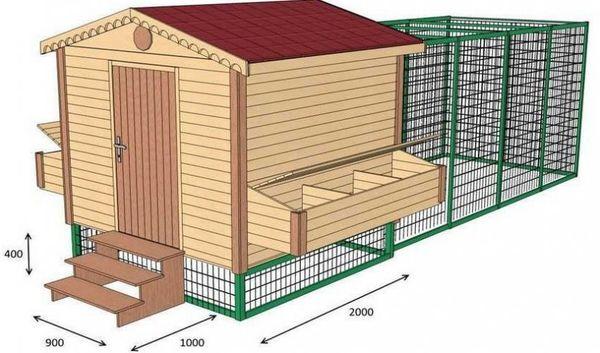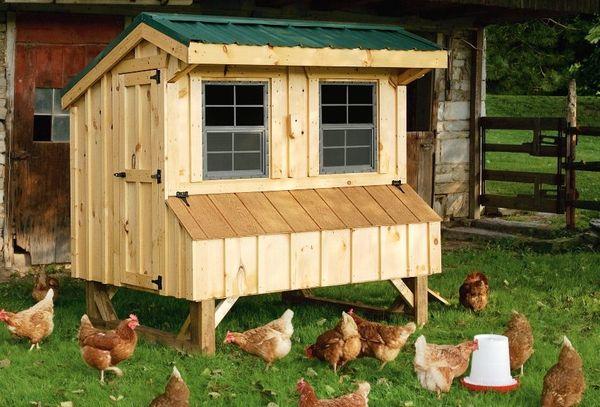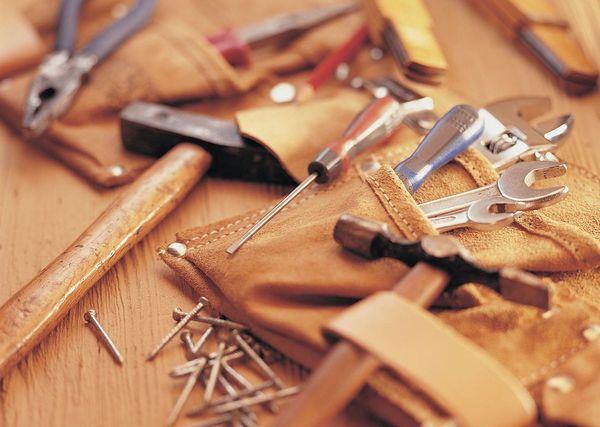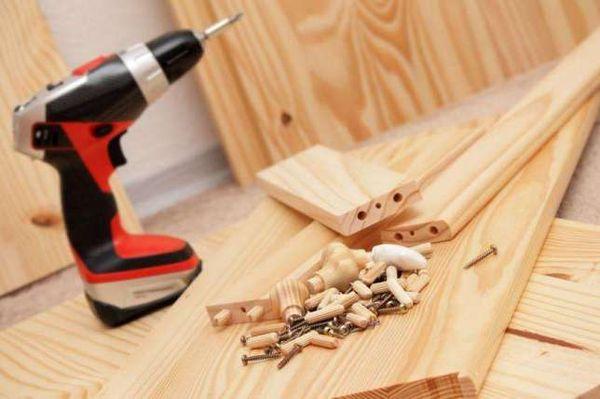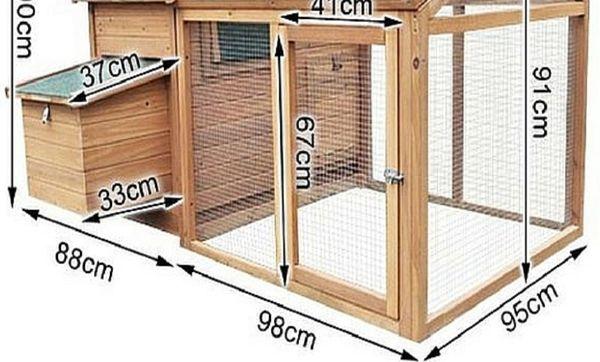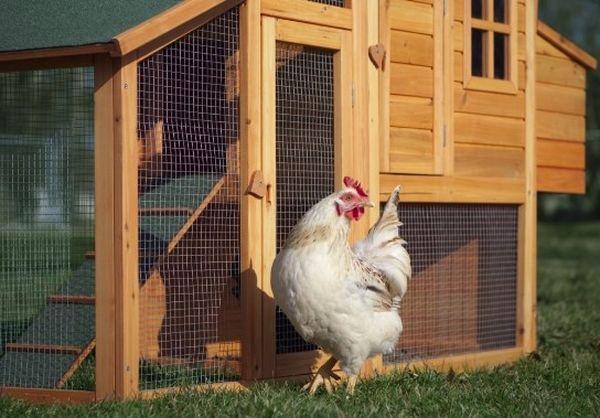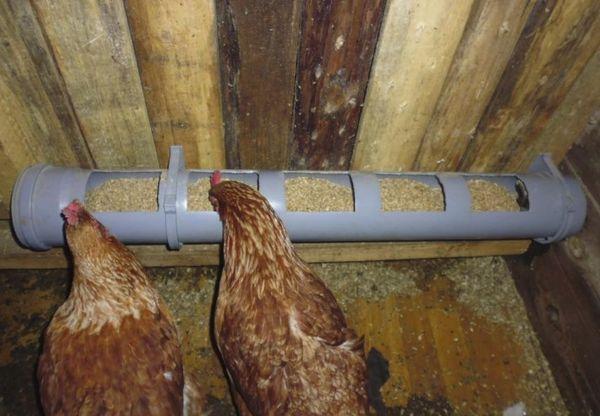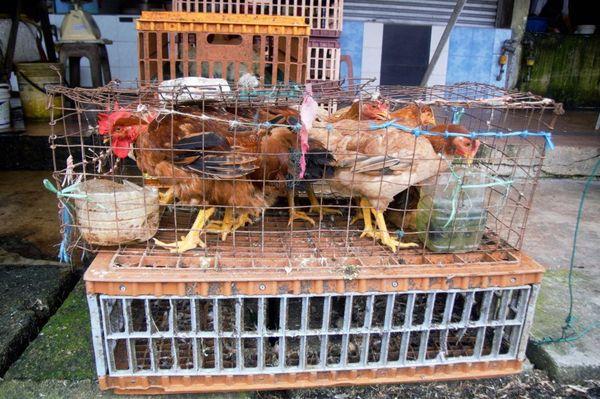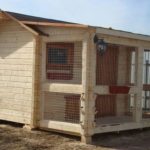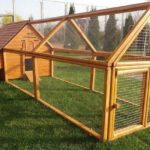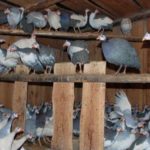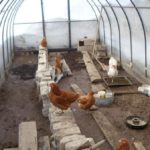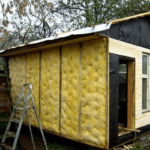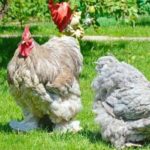To keep poultry, owners often resort to building a chicken coop in their dacha themselves. This is possible when the number of birds amounts to several dozen. You can build a poultry house in small areas. Before construction, the dimensions of the poultry house are calculated, the structure of materials is selected, and the necessary tools are prepared.
- Which poultry housing option do you prefer?
- Layout, dimensions, drawings
- Choosing a place to build
- Materials and tools for work
- Construction process
- Foundation
- Floor
- Walling
- Roof
- Wall cladding
- What to put inside
- Ventilation device
- Lighting
- Perches and nests
- Litter
- Feeders
- What to take care of in winter
- Poultry aviary
Which poultry housing option do you prefer?
To make a choice of the type of chicken coop at your dacha, you should focus on the following criteria:
- number of birds, average age;
- the season when the chicken coop will be used;
- taking into account the possibility of cleaning and disinfecting the premises.
Simple poultry houses are built for use in summer and spring; autonomous ones are built when they plan to keep birds all year round.
Layout, dimensions, drawings
The layout of the chicken coop depends on how many birds will live indoors. The 5-head project is designed for 2.5 square meters of usable area, to which about 30 percent of the area is added to support three nests. To build a five-person poultry house, you will need 3.2 square meters, taking into account a ceiling height of at least 1.8 meters.
When calculating the area for 10 chickens, the dimensions are doubled. For a building for 15 heads - three times. Almost a five-person house on a summer cottage plot of 6 acres can fit on an area of about 2.8 square meters. Poultry houses for the summer period are built with the obligatory consideration of the area for walking, because in the summer the chickens will spend a lot of time outside.
The drawing for the construction of a standard chicken coop for 15 heads includes the calculation of building materials based on the size of the area:
- size - 180 by 200 centimeters or 3.6 square meters, with a ceiling height of 200 centimeters;
- the minimum standard for building a paddock is about 10 square meters for 20 heads;
- when planning breeding, take into account the need for an extension for sick chickens in order to be able to create quarantine conditions
Information! Sanitary and epidemiological standards provide for the placement of 3-4 heads of chickens per 1 square meter of area.
Choosing a place to build
Before starting construction, choose a location. It must meet several requirements so that there are no problems with keeping birds in the future:
- The soil surface for construction must be dry. Poultry houses are not built in lowlands, where rain puddles can accumulate. Slopes and depressions are excluded.
- Swampy or clayey soil is specially dried before erecting buildings. For this purpose, trenches and artificial drains are specially created.
- The chicken coop can be located on a small hill, eliminating the possibility of constant through winds. Winds are eliminated due to the location next to additional country houses on one side.
- The walking area is planned taking into account the fact that it will be possible to create shading areas there. If it is too hot on the site, the chickens will gravitate indoors.
Materials and tools for work
Construction requires materials that can be divided into several groups.
| For the foundation | For the roof | For walls | Materials for processing and fastening |
| Cement, sand | Slate | Armature | Metallized tape |
| Gravel | Insulation membrane | Edged board | Antiseptic for wood |
| Expanded clay | Ruberoid | Wooden beam |
To build a chicken coop with your own hands, use the following tools:
- bayonet-type shovel for digging up an area;
- hand drill;
- hacksaw for wood;
- construction stapler;
- screwdriver;
- concrete mixer.
In addition, you need to prepare available tools: tape measure, level, marking pencil, pegs, rope.
Construction process
To build a chicken coop with your own hands, you must follow certain rules. The buildings are erected according to the established stage-by-stage plan.
Foundation
The first stage of construction is pouring the foundation.Most often, a columnar type of foundation is used for poultry houses. It has several advantages:
- the risk of flooding is eliminated;
- good ventilation;
- protection from small rodents;
- minimum cash costs.
After marking, holes are dug, then sand is poured, bricks are installed, and cement is poured. The pillars are built from pairs of bricks or foam blocks. Their height is adjusted as necessary.
Floor
To make the floor, wait for the foundation to settle, and then make a wooden frame from timber. Before putting together a box, the wooden beam is treated with an antiseptic to prevent rotting processes. After installing the box, the floor is covered with a rough board. Before each stage of construction, the wood is treated with antiseptic agents.
Walling
The walls are erected using a frame method. An edged board is mounted in the corners, securing it with corners and screws. The racks are fixed with top straps made of boards with the same cross-sectional parameters.
The intermediate support of the sheathing is installed in accordance with the dimensions of the thermal insulation material for the walls.
Roof
The roof is installed after the frame is erected. The rafters are treated with an antiseptic. They begin to fix them after they are completely dry. The rafters are placed on edge and attached to the top sheathing of the frame. The distance between the rafters is calculated based on the width of the insulation. Polyethylene film is laid on top of the rafters, then lathing and roofing material.
Wall cladding
A vapor barrier membrane is placed between the main frame posts and secured with a construction stapler. Then the mineral wool is laid so that it fits tightly to the supports.
To insulate the roof, the material is laid between the rafters. The floor is sealed with pitch or cotton wool, and the cracks are carefully sealed with it.
What to put inside
When building a chicken coop, it is necessary to take into account the presence of ventilation. Drafts and high humidity are equally contraindicated for chickens.
Ventilation device
To ventilate a room built using a frame type, 2 openings of the same size are installed. They are placed opposite each other. One of the holes is cut 40 centimeters lower than the other to avoid drafts.
Lighting
For lighting choose:
- 1 or 2 fluorescent lamps;
- LED strip from 20 to 30 centimeters long.
Electrical wiring is carried out inside the plastic corrugation, using a copper cable of the selected cross-section.
Perches and nests
Construction of perches and installation of nests require compliance with certain rules:
- For perches, areas of the room near the windows are chosen, they are fixed at a height of 40 to 70 centimeters from the floor; made from wooden profiles or bars.
- A distance of about 25-30 centimeters is left between adjacent perches.
- The nests are installed on low legs made of boxes 20 centimeters wide and long - these are open nests.
- Closed nests should be larger, their approximate size is 30 by 40 centimeters, they are made of plywood, chickens feel safe in such nests. They are necessary when birds are hatching their offspring; winter chicken coops cannot be done without them.
Litter
To ensure comfortable living, as well as to keep the chickens warm, the bottom of the nests is lined with sawdust or straw. This material is used for flooring.
Advice! Sawdust is changed twice a month. The straw is changed as needed.
Feeders
For chickens, feeders are arranged at a low height above the floor.If you leave a container of food on the floor, the chickens will begin to rake it, trample it, and most of it will become unfit for consumption.
Feeders are made of plastic. Bottles and cans are suitable. They are screwed to the walls, making them removable so that they can be constantly washed or wiped.
Drinkers are placed away from feeders so that water does not mix with food. For drinking bowls, scraps of plastic pipes with holes cut out are used. Drinkers and feeders should be wide enough to accommodate as many chickens as possible without fighting.
What to take care of in winter
In winter, chickens need extra warmth. The chicken coop is heated in one of two ways:
- Installation of a fan heater. Programmable models significantly save energy.
- Canopy of infrared lamps. They are placed above the perch and above the floor. The peculiarity of the method is that the temperature of the room will not increase significantly, but the chickens that are under infrared light will be warm enough.
Warning! Lamps are placed so that they do not interfere with the free movement of birds.
Poultry aviary
Walking birds is an important part of care. It is necessary to solve several problems:
- marking the territory for the location of poultry;
- elimination of losses;
- protection from other pets.
Walking is arranged according to one of the following types:
- Mobile aviary. It is necessary when chicken coops are set up for the summer. This option has several advantages. As the greenery is destroyed, the enclosures are moved to a new area, providing the chickens with food.
- Stationary aviary. It is attached to autonomous chicken coops. It can be built with any type of foundation.A mesh is stretched around the perimeter, the height of which should not be less than 60-70 centimeters.
- Mobile aviary. This is a type of portable walking device. It is designed on wheels, which makes it easier to move around the dacha area. As a rule, such structures are completely covered with greenhouse-type mesh and equipped with a door.
Aviary structures are equipped with feeders and drinkers, because chickens are out on the run all day long in the summer. Stationary buildings that are installed on a foundation are covered with straw or sawdust. The bird can be out for a walk for several hours during the cold season.

